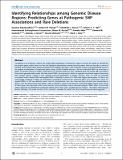| dc.contributor.author | Daly, Mark J. | |
| dc.contributor.author | Altshuler, David | |
| dc.contributor.author | Xavier, Ramnik J. | |
| dc.contributor.author | Sklar, Pamela | |
| dc.contributor.author | Purcell, Shaun M. | |
| dc.contributor.author | International Schizophrenia Consortium | |
| dc.contributor.author | Ng, Aylwin C. Y. | |
| dc.contributor.author | Scolnick, Edward Mark | |
| dc.contributor.author | Rossin, Elizabeth | |
| dc.contributor.author | Plenge, Robert M. | |
| dc.contributor.author | Raychaudhuri, Soumya | |
| dc.date.accessioned | 2010-05-28T15:02:09Z | |
| dc.date.available | 2010-05-28T15:02:09Z | |
| dc.date.issued | 2009-06 | |
| dc.date.submitted | 2009-02 | |
| dc.identifier.issn | 1553-7390 | |
| dc.identifier.issn | 1553-7404 | |
| dc.identifier.uri | http://hdl.handle.net/1721.1/55344 | |
| dc.description.abstract | Translating a set of disease regions into insight about pathogenic mechanisms requires not only the ability to identify the key disease genes within them, but also the biological relationships among those key genes. Here we describe a statistical method, Gene Relationships Among Implicated Loci (GRAIL), that takes a list of disease regions and automatically assesses the degree of relatedness of implicated genes using 250,000 PubMed abstracts. We first evaluated GRAIL by assessing its ability to identify subsets of highly related genes in common pathways from validated lipid and height SNP associations from recent genome-wide studies. We then tested GRAIL, by assessing its ability to separate true disease regions from many false positive disease regions in two separate practical applications in human genetics. First, we took 74 nominally associated Crohn's disease SNPs and applied GRAIL to identify a subset of 13 SNPs with highly related genes. Of these, ten convincingly validated in follow-up genotyping; genotyping results for the remaining three were inconclusive. Next, we applied GRAIL to 165 rare deletion events seen in schizophrenia cases (less than one-third of which are contributing to disease risk). We demonstrate that GRAIL is able to identify a subset of 16 deletions containing highly related genes; many of these genes are expressed in the central nervous system and play a role in neuronal synapses. GRAIL offers a statistically robust approach to identifying functionally related genes from across multiple disease regions—that likely represent key disease pathways. An online version of this method is available for public use (http://www.broad.mit.edu/mpg/grail/). | en |
| dc.language.iso | en_US | |
| dc.publisher | Public Library of Science | en |
| dc.relation.isversionof | http://dx.doi.org/10.1371/journal.pgen.1000534 | en |
| dc.rights | Creative Commons Attribution | en |
| dc.rights.uri | http://creativecommons.org/licenses/by/2.5/ | en |
| dc.source | PLoS | en |
| dc.title | Identifying Relationships among Genomic Disease Regions: Predicting Genes at Pathogenic SNP Associations and Rare Deletions | en |
| dc.type | Article | en |
| dc.identifier.citation | Raychaudhuri, Soumya et al. “Identifying Relationships among Genomic Disease Regions: Predicting Genes at Pathogenic SNP Associations and Rare Deletions.” PLoS Genet 5.6 (2009): e1000534. © 2009 Raychaudhuri et al. | en |
| dc.contributor.department | Whitaker College of Health Sciences and Technology | en_US |
| dc.contributor.department | Broad Institute of MIT and Harvard | en_US |
| dc.contributor.department | Massachusetts Institute of Technology. Department of Biology | en_US |
| dc.contributor.approver | Scolnick, Edward Mark | |
| dc.contributor.mitauthor | Daly, Mark J. | |
| dc.contributor.mitauthor | Altshuler, David | |
| dc.contributor.mitauthor | Sklar, Pamela | |
| dc.contributor.mitauthor | Scolnick, Edward Mark | |
| dc.contributor.mitauthor | Rossin, Elizabeth | |
| dc.contributor.mitauthor | Plenge, Robert M. | |
| dc.contributor.mitauthor | Raychaudhuri, Soumya | |
| dc.relation.journal | PLoS Genetics | en |
| dc.eprint.version | Final published version | en |
| dc.type.uri | http://purl.org/eprint/type/JournalArticle | en |
| eprint.status | http://purl.org/eprint/status/PeerReviewed | en |
| dspace.orderedauthors | Raychaudhuri, Soumya; Plenge, Robert M.; Rossin, Elizabeth J.; Ng, Aylwin C. Y.; Purcell, Shaun M.; Sklar, Pamela; Scolnick, Edward M.; Xavier, Ramnik J.; Altshuler, David; Daly, Mark J. | en |
| dc.identifier.orcid | https://orcid.org/0000-0001-6757-5341 | |
| dc.identifier.orcid | https://orcid.org/0000-0002-7250-4107 | |
| mit.license | PUBLISHER_CC | en |
| mit.metadata.status | Complete | |
